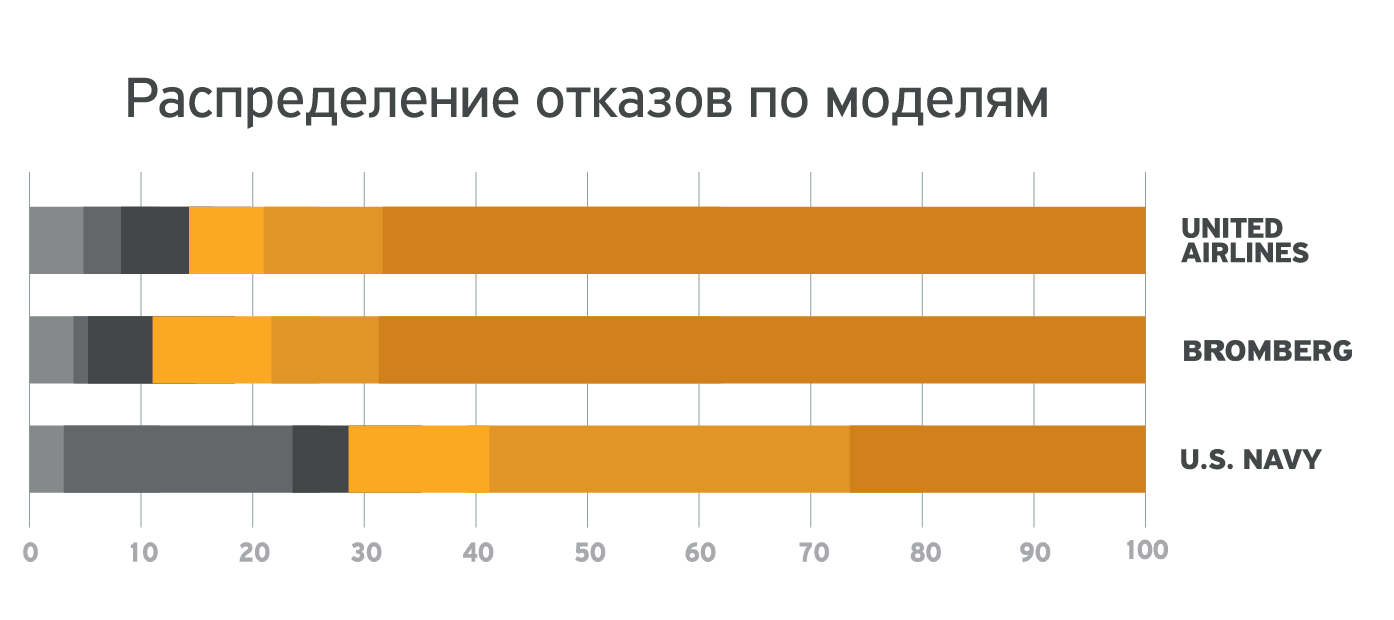
Studies have shown that on the use of any equipment in any enterprise, there are only 6 scenarios for the failure of this equipment. Graphically, all these scenarios can be depicting as follows: if we plot the probability of equipment failure on the vertical axis and the time (life cycle) of the equipment operation on the horizontal axis, we get the following picture, which displays 6 scenarios of equipment failure.
A. Equipment is out of order either at the beginning of its using period or at the end B. Equipment fails at the end of the using period C. The reliability of the equipment is constantly deteriorating, it can fail at any time, but the older it is, the greater the probability of its breakage. D. The equipment exactly does not fail at the beginning of using. The probability of failure at any other time is constant. E. The probability of equipment failure is the same, regardless of the equipment's time of using. F. If the equipment does not fail at the beginning of its using, then the probability of failure at any other time is constant.
The above graphs allow us to draw several important conclusions. If the equipment will fail under scenario A, B or C, then planned preventive repair, which is carring out by most companies, can effectively prevent equipment breakdown. However, in the case of scenarios D, E or F, the method planned preventive repair is inappropriate, since it only leads to additional costs of resources, without affecting the reliability of the equipment and its durability. This is because not always the theoretical term of service of components corresponds to the actual one, and the details must be replacing not based on the anticipated planned wear, but based on their actual state. The British scientist Conrad Hal Waddington was first who came to this conclusion and applied a new maintenance concept to the B-24 bombers of the Royal Air Force of Great Britain during the Second World War. Thanks to the application of the new approach, it was possible not only to reduce the amount of time and means needed to repair and maintain aircraft, but also to increase their reliability.
RCM
The new approach to servicing was called RCM - Reliability-Centered Maintenance. It was gradually adopted by all leading industrial enterprises, because proving to be effective both in cost savings and in ensuring the reliability of the serviced mechanisms.
The argument for the adoption of RCM as a more effective approach to service was the analysis of statistics of failure of different nodes, assembles, which was conducted in their time by the companies Bromberg, United Airlines and even by the US Navy. Statistics showed that out of the existing 6 scenarios breakdowns of mechanisms, certain scenarios have a much higher frequency than others.


After receiving this information, it was suggested to compare the frequency of the scenarios with the possibility of their prevention with the help of the planned preventive repair. The data obtained were as follows.

As can be seen from the info graphics, for all companies the probability of equipment failure under the scenarios F, E and D was an absolute majority. Taking into account these data, a decision was made to refuse the implementation of the planned preventive repair and to transition to RCM-maintenance. Conducting the planned preventive repair was not only more costly, but also ineffective: on average, only 20% of the malfunctions could be eliminated even before their manifestation with the help of the planned preventive repair.
Thus, the world's leading enterprises began to abandon the planned preventive repair in the 70's, and today RCM-maintenance is the most progressive and effective approach for any manufacturing enterprise.
